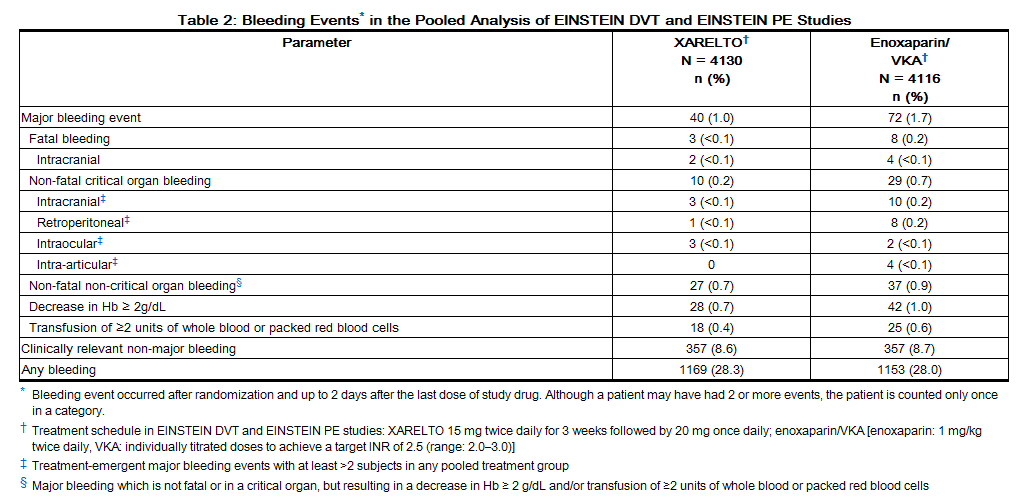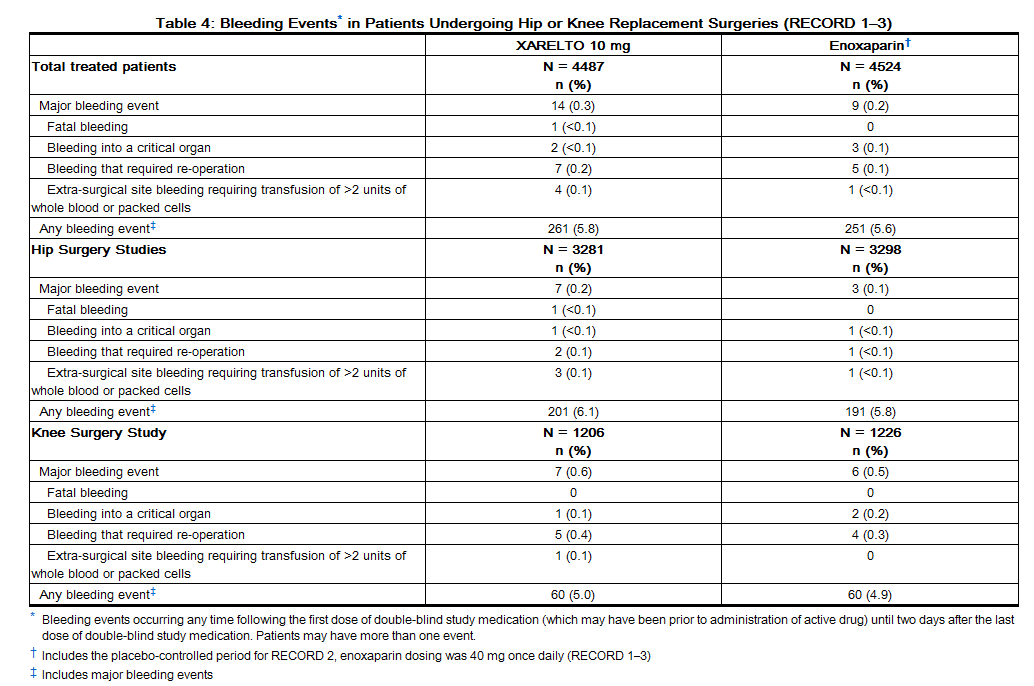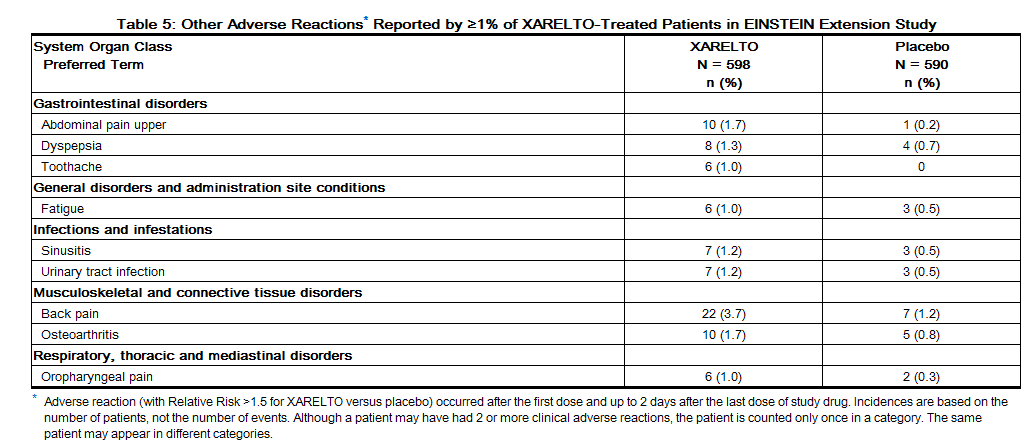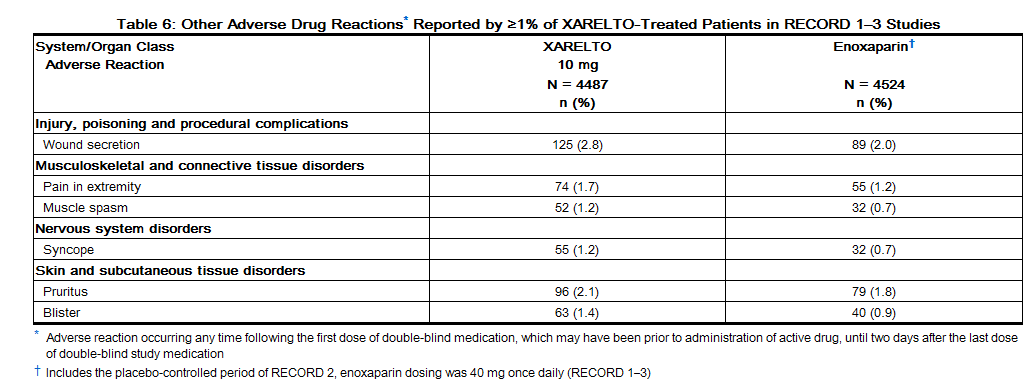Rivaroxaban adverse reactions: Difference between revisions
No edit summary |
No edit summary |
||
| Line 5: | Line 5: | ||
The following adverse reactions are also discussed in other sections of the labeling: | The following adverse reactions are also discussed in other sections of the labeling: | ||
*Increased risk of [[stroke]] after discontinuation in nonvalvular [[atrial fibrillation]] [see [[Rivaroxaban warnings and precautions|Boxed Warning and Warnings and Precautions | *Increased risk of [[stroke]] after discontinuation in nonvalvular [[atrial fibrillation]] [see [[Rivaroxaban warnings and precautions|Boxed Warning and Warnings and Precautions]]] | ||
*Bleeding risk [see[[Rivaroxaban warnings and precautions|Warnings and Precautions | *Bleeding risk [see[[Rivaroxaban warnings and precautions|Warnings and Precautions ]]] | ||
*Spinal/[[epidural hematoma]] [see [[Rivaroxaban warnings and precautions|Boxed Warning and Warnings and Precautions | *Spinal/[[epidural hematoma]] [see [[Rivaroxaban warnings and precautions|Boxed Warning and Warnings and Precautions]]] | ||
=== | === Clinical Trials Experience=== | ||
Because clinical trials are conducted under widely varying conditions, adverse reaction rates observed in the clinical trials of a drug cannot be directly compared to rates in the clinical trials of another drug and may not reflect the rates observed in clinical practice. | Because clinical trials are conducted under widely varying conditions, adverse reaction rates observed in the clinical trials of a drug cannot be directly compared to rates in the clinical trials of another drug and may not reflect the rates observed in clinical practice. | ||
| Line 19: | Line 19: | ||
====Hemorrhage==== | ====Hemorrhage==== | ||
The most common adverse reactions with XARELTO were bleeding complications [see [[Rivaroxaban warnings and precautions|Warnings and Precautions | The most common adverse reactions with XARELTO were bleeding complications [see [[Rivaroxaban warnings and precautions|Warnings and Precautions]]]. | ||
| Line 27: | Line 27: | ||
Table 1 shows the number of patients experiencing various types of bleeding events in the ROCKET AF trial. | Table 1 shows the number of patients experiencing various types of bleeding events in the ROCKET AF trial. | ||
{| | |||
[[image:riva3.png]] | |[[image:riva3.png|600px|thumb]] | ||
|} | |||
===Treatment of Deep Vein Thrombosis (DVT), Pulmonary Embolism (PE), and to Reduce the Risk of Recurrence of DVT and of PE=== | ===Treatment of Deep Vein Thrombosis (DVT), Pulmonary Embolism (PE), and to Reduce the Risk of Recurrence of DVT and of PE=== | ||
| Line 37: | Line 37: | ||
Table 2 shows the number of patients experiencing major bleeding events in the pooled analysis of the EINSTEIN DVT and EINSTEIN PE studies. | Table 2 shows the number of patients experiencing major bleeding events in the pooled analysis of the EINSTEIN DVT and EINSTEIN PE studies. | ||
{| | |||
[[image:riva4.png]] | |[[image:riva4.png|600px|thumb]] | ||
|} | |||
====EINSTEIN Extension Study==== | ====EINSTEIN Extension Study==== | ||
| Line 45: | Line 45: | ||
Table 3 shows the number of patients experiencing bleeding events in the EINSTEIN Extension study. | Table 3 shows the number of patients experiencing bleeding events in the EINSTEIN Extension study. | ||
{| | |||
[[image:riva5.png]] | |[[image:riva5.png|600px|thumb]] | ||
|} | |||
===Prophylaxis of Deep Vein Thrombosis Following Hip or Knee Replacement Surgery === | ===Prophylaxis of Deep Vein Thrombosis Following Hip or Knee Replacement Surgery === | ||
| Line 53: | Line 53: | ||
The rates of major bleeding events and any bleeding events observed in patients in the RECORD clinical trials are shown in Table 4. | The rates of major bleeding events and any bleeding events observed in patients in the RECORD clinical trials are shown in Table 4. | ||
{| | |||
[[image:riva6.png]] | [[image:riva6.png|600px|thumb]] | ||
|} | |||
Following XARELTO treatment, the majority of major bleeding complications (≥60%) occurred during the first week after surgery. | Following XARELTO treatment, the majority of major bleeding complications (≥60%) occurred during the first week after surgery. | ||
| Line 61: | Line 61: | ||
Non-hemorrhagic adverse reactions reported in ≥1% of XARELTO-treated patients in the EINSTEIN Extension study are shown in Table 5. | Non-hemorrhagic adverse reactions reported in ≥1% of XARELTO-treated patients in the EINSTEIN Extension study are shown in Table 5. | ||
{| | |||
[[image:riva7.png]] | |[[image:riva7.png|600px|thumb]] | ||
|} | |||
Non-hemorrhagic adverse reactions reported in ≥1% of XARELTO-treated patients in RECORD 1–3 studies are shown in Table 6. | Non-hemorrhagic adverse reactions reported in ≥1% of XARELTO-treated patients in RECORD 1–3 studies are shown in Table 6. | ||
{| | |||
[[image:riva8.png]] | |[[image:riva8.png|600px|thumb]] | ||
|} | |||
'''Other clinical trial experience:''' In an investigational study of acute medically ill patients being treated with XARELTO 10 mg tablets, cases of [[pulmonary hemorrhage]] and pulmonary hemorrhage with [[bronchiectasis]] were observed. | '''Other clinical trial experience:''' In an investigational study of acute medically ill patients being treated with XARELTO 10 mg tablets, cases of [[pulmonary hemorrhage]] and pulmonary hemorrhage with [[bronchiectasis]] were observed. | ||
=== | === Postmarketing Experience=== | ||
The following adverse reactions have been identified during post-approval use of rivaroxaban. Because these reactions are reported voluntarily from a population of uncertain size, it is not always possible to reliably estimate their frequency or establish a causal relationship to drug exposure. | The following adverse reactions have been identified during post-approval use of rivaroxaban. Because these reactions are reported voluntarily from a population of uncertain size, it is not always possible to reliably estimate their frequency or establish a causal relationship to drug exposure. | ||
Revision as of 03:22, 13 March 2014
Editor-In-Chief: C. Michael Gibson, M.S., M.D. [1]; Associate Editor(s)-in-Chief: Ahmed Zaghw, M.D. [2]
Adverse Reactions
The following adverse reactions are also discussed in other sections of the labeling:
- Increased risk of stroke after discontinuation in nonvalvular atrial fibrillation [see Boxed Warning and Warnings and Precautions]
- Bleeding risk [seeWarnings and Precautions ]
Clinical Trials Experience
Because clinical trials are conducted under widely varying conditions, adverse reaction rates observed in the clinical trials of a drug cannot be directly compared to rates in the clinical trials of another drug and may not reflect the rates observed in clinical practice.
During clinical development for the approved indications, 16326 patients were exposed to XARELTO. These included 7111 patients who received XARELTO 15 mg or 20 mg orally once daily for a mean of 19 months (5558 for 12 months and 2512 for 24 months) to reduce the risk of stroke and systemic embolism in nonvalvular atrial fibrillation (ROCKET AF); 4728 patients who received either XARELTO 15 mg orally twice daily for three weeks followed by 20 mg orally once daily (EINSTEIN DVT, EINSTEIN PE) or 20 mg orally once daily (EINSTEIN Extension) to treat DVT, PE, and to reduce the risk of recurrence of DVT and of PE; and 4487 patients who received XARELTO 10 mg orally once daily for prophylaxis of DVT following hip or knee replacement surgery (RECORD 1–3).
Hemorrhage
The most common adverse reactions with XARELTO were bleeding complications [see Warnings and Precautions].
Nonvalvular Atrial Fibrillation
In the ROCKET AF trial, the most frequent adverse reactions associated with permanent drug discontinuation were bleeding events, with incidence rates of 4.3% for XARELTO vs. 3.1% for warfarin. The incidence of discontinuations for non-bleeding adverse events was similar in both treatment groups.
Table 1 shows the number of patients experiencing various types of bleeding events in the ROCKET AF trial.
 |
Treatment of Deep Vein Thrombosis (DVT), Pulmonary Embolism (PE), and to Reduce the Risk of Recurrence of DVT and of PE
EINSTEIN DVT and EINSTEIN PE Studies
In the pooled analysis of the EINSTEIN DVT and EINSTEIN PE clinical studies, the most frequent adverse reactions leading to permanent drug discontinuation were bleeding events, with XARELTO vs. enoxaparin/Vitamin K antagonist (VKA) incidence rates of 1.7% vs. 1.5%, respectively. The mean duration of treatment was 208 days for XARELTO-treated patients and 204 days for enoxaparin/VKA-treated patients.
Table 2 shows the number of patients experiencing major bleeding events in the pooled analysis of the EINSTEIN DVT and EINSTEIN PE studies.
 |
EINSTEIN Extension Study
In the EINSTEIN Extension clinical study, the most frequent adverse reactions associated with permanent drug discontinuation were bleeding events, with incidence rates of 1.8% for XARELTO vs. 0.2% for placebo treatment groups. The mean duration of treatment was 190 days for both XARELTO and placebo treatment groups.
Table 3 shows the number of patients experiencing bleeding events in the EINSTEIN Extension study.
 |
Prophylaxis of Deep Vein Thrombosis Following Hip or Knee Replacement Surgery
In the RECORD clinical trials, the overall incidence rate of adverse reactions leading to permanent treatment discontinuation was 3.7% with XARELTO.
The rates of major bleeding events and any bleeding events observed in patients in the RECORD clinical trials are shown in Table 4.

Following XARELTO treatment, the majority of major bleeding complications (≥60%) occurred during the first week after surgery.
Other Adverse Reactions
Non-hemorrhagic adverse reactions reported in ≥1% of XARELTO-treated patients in the EINSTEIN Extension study are shown in Table 5.
 |
Non-hemorrhagic adverse reactions reported in ≥1% of XARELTO-treated patients in RECORD 1–3 studies are shown in Table 6.
 |
Other clinical trial experience: In an investigational study of acute medically ill patients being treated with XARELTO 10 mg tablets, cases of pulmonary hemorrhage and pulmonary hemorrhage with bronchiectasis were observed.
Postmarketing Experience
The following adverse reactions have been identified during post-approval use of rivaroxaban. Because these reactions are reported voluntarily from a population of uncertain size, it is not always possible to reliably estimate their frequency or establish a causal relationship to drug exposure.
Blood and lymphatic system disorders: agranulocytosis
Gastrointestinal disorders: retroperitoneal hemorrhage
Hepatobiliary disorders: jaundice, cholestasis, cytolytic hepatitis
Immune system disorders: hypersensitivity, anaphylactic reaction, anaphylactic shock, angioedema
Nervous system disorders: cerebral hemorrhage, subdural hematoma, epidural hematoma, hemiparesis
Skin and subcutaneous tissue disorders: Stevens-Johnson syndrome[1]
References
Adapted from the FDA Package Insert.